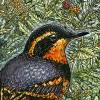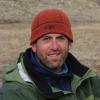

Join BirdNote tomorrow, November 30th!
Illustrator David Sibley and actor H. Jon Benjamin will face off in the bird illustration battle of the century during BirdNote's Year-end Celebration and Auction!
In the animal world, large, charismatic species tend to get the most attention. But for the Kori Bustard, the largest flying bird in Africa, that attention hasn't translated to a ton of scientific research. Katherine Mertes, a research ecologist at the Smithsonian Conservation Biology Institute, tracks animals for a living, and a few years ago she was focused on Kori Bustards. Her team used solar-powered tracking devices to study the bustards’ movements. But first, they had to catch the birds — and trying to gently herd a bustard into a giant net is quite a task.
BirdNote®
Catching Kori Bustards for Science
Written by Kevin McLean
This is BirdNote.
[Kori Bustard calls, AV 17637, 0:11-0:13]
In the animal world, large, charismatic species tend to get the most attention. But for the Kori Bustard, the largest flying bird in Africa, that attention hasn't translated to a ton of scientific research. They’re still common in parks and reserves, but their populations are dropping outside of protected areas.
Katherine Mertes: They're not that well-studied…And we don't know a whole lot about their habitat preferences.
That's Katherine Mertes, a research ecologist at the Smithsonian Conservation Biology Institute. She tracks animals for a living, and a few years ago she was focused on Kori Bustards.
Katherine Mertes: Uh, it is a tale of mostly unrequited love. [8:56] We had these solar powered tracking devices. They're held on to the bird, using a backpack harness made of Teflon-coated ribbon.
But to put them on the birds, they had to catch them. And for a big bird, you’re gonna need a bigger net.
Katherine Mertes: You string this three meter tall, 30 meter long net on poles or mostly natural vegetation.
Trying to gently herd a bustard into the huge nets turned out to be quite a task. In an entire field season, they only caught three birds, out of 40 to 50 attempts—
Katherine Mertes: It took three to six people and one to two vehicles and lots and lots of hours in the field. We had one that walked basically right up to the net. And he just pumped his legs and took off straight up into the air.
[Kori Bustard taking flight, ML 31373311, 0:00-0:03]
But they fitted the three birds they did catch with their little tracking backpacks, which provided years of data that can help with future conservation planning.
[Kori Bustard calls, AV 17637, 0:17-0:19]
For BirdNote, I'm Kevin McLean.
###
Senior Producer: John Kessler
Content Director: Allison Wilson
Producer: Mark Bramhill
Managing Producer: Conor Gearin
Bird sounds provided by The Macaulay Library of Natural Sounds at the Cornell Lab of Ornithology, Ithaca, New York. Kori Bustard calls AVoCet 17637 recorded by P.C. Rasmussen, and Kori Bustard ML 31373311 recorded by A. Spencer.
BirdNote’s theme was composed and played by Nancy Rumbel and John Kessler.
© 2022 BirdNote September 2022
Narrator: Kevin McLean
ID# KORBUS-01-2022-09-08 KORBUS-01




